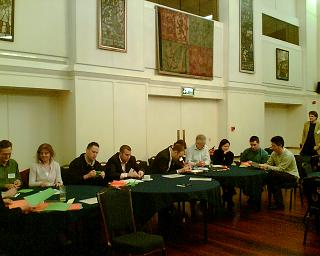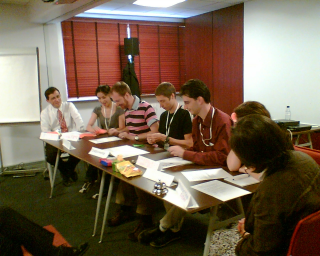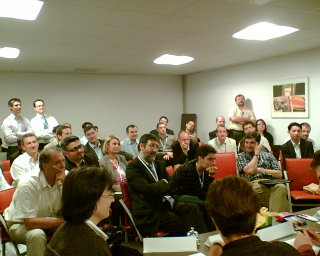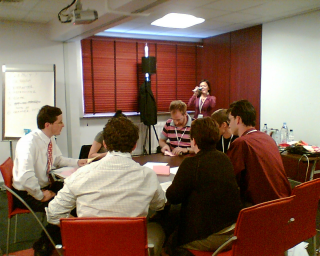Starting up a book reading group
J., the manager of the Financial systems IT department, came to me for advice. He wanted to expand his developers’ knowledge and responsibilities. He wanted them to grow beyond pure development: to get more involved in architecture and analysis, interact with customers… We looked at several options and finally decided to start up a book reading group.
In a book reading group, a number of people get together to read and discuss a chosen book. To set up a book reading group:
- Invite participants. Participation isn’t mandatory.
- Select a book that interests the participants.
- Get enough copies of the book, so that everyone can choose when to read.
- Define a suitable reading pace. For example one chapter per week. Keep the iterations short.
- Agree on a fixed meeting schedule, time and place to discuss the book. The discussion is often scheduled during a lunch break, with lunch provided by the company.
- Moderate the discussion and record the main insights, so that there’s an output and those who miss a session can catch up.
The quiet team
There was something unusual about this team. They were so… quiet. You probably don’t want your accounting, invoicing and ERP systems maintained by a bunch of party animals, but still. These developers rarely talked to each other, they all worked individually on their own part of the systems. I was a bit worried: would they come to the discussion meetings? Would they say something?
What would be a useful book for this team? They all had different backgrounds, worked on different applications and used different technologies. I proposed we should start with something that would be useful as a basis for further study. We chose “Quality Management I: Systems Thinking” by Gerald Weinberg. I’ve found Systems Thinking to be a useful tool to make sense of a lot of situations, but would the team find it interesting? Would a book about “management” be useful for developers? The manager and I decided it was worth the risk.
We’ve noticed that some people will find or create the time to read books to learn more, but they are the exception rather than the rule. Many people are so busy at work that they don’t have the time to read books. Reading a book isn’t “work”. And the principle of “sustainable pace” surely means you shouldn’t be spending time reading work-related stuff outside of work.
The reading group has a number of advantages:
- Reading becomes part of “work”.
- Peer-pressure and the short timeboxes ensure that participants create the time to read one chapter every week.
- The discussion sessions ensure that participants read more attentively and hear how others interpret the material.
- The discussion regularly leads to ideas for improvement actions or people getting together to try out some new idea.
- Reading the book together improves team cohesion and (cross-)team communication. Even if participants work on different applications or work in different teams, they’re doing something together and realise that they face the same issues.
- A reading group reveals strengths, weaknesses and skills in individuals you wouldn’t usually notice about one another working together day-to-day. This discovery could lead to increased appreciation among team members which, in turn, leads to increased respect.
Group learning
The first couple of sessions required a lot of facilitation to get participants to speak up and give their opinion. The participants didn’t see the relevance of systems thinking. And why were we reading a book about management? They weren’t managers. They were developers.
Luckily, they kept coming to the book group, they didn’t give up. Gradually, they started to speak up more; discussions started; they debated different viewpoints. They started to see things in their environment, things that had always been there. But now they saw the world with different eyes. They started to see the connections between things. They started to understand why things happened as they did. They started to realise how they could influence their environment. They started to generate ideas to improve the way they worked. The group required less and less facilitation: two participants emerged as leaders, they kept things going. I didn’t have to say anything; I just acted as their scribe. The team was no longer quiet; they were full of energy and ideas.
When starting up a reading group:
- Ensure that there’s enough support and encouragement from the coach, a manager or some team members to get the group going. The first two chapters of a book are often not very exciting; the group needs to get to know each other and the format.
- Small signs of company support like paying for the books, providing a place to meet and buying lunch shows participants that they and their growth are taken seriously.
- Provide facilitation to get the discussion going and to keep the meeting on track. As the group gets more experience and self-organises, they will require less facilitation.
- Take notes and publish them so that those who weren’t present can see the outcome. Publishing an output raises the importance of the meeting.
- Ensure that the book is relevant to the work of the team. Let the team describe what they want to learn. The coach should have enough experience to suggest books that fulfil the requirements of the team.
- As with iterations, a regular pace with short iterations is crucial. We recommend weekly sessions, to discuss one or two chapters.
- Ensure you always meet in the same room at the same time. Don’t reschedule the book group meetings because someone can’t attend. They can always catch up.
- In a larger or more heterogeneous team you can create two groups who read a different book. Discussing the two books together gives everyone some insight into both books. Maybe the participants will find interesting links or contradictions between both books.
- Try to find books that contain questions or exercises for the reader. Participants must answer one question or perform one exercise per chapter. The group facilitator can set up questions or exercises for the group.
- If participants are uncomfortable during discussions, the facilitator can use techniques like a clustering exercise to elicit everyone’s input.
- The discussion will often result in ideas for improvement and action. Handle these like you would at a retrospective: prioritise them by value and include them as part of the team’s delivery iteration.


 We start the day with a refreshing run up the Champs Elysées, down to the Eiffel tower and along the Seine. I’ve been looking forward to this day: I will meet two of my heroes!
We start the day with a refreshing run up the Champs Elysées, down to the Eiffel tower and along the Seine. I’ve been looking forward to this day: I will meet two of my heroes!


 OCTO brought
OCTO brought